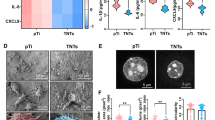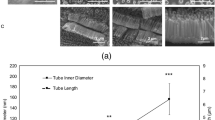Abstract
Titanium (Ti) implants with TiO2 nanotubular arrays on the surface could regulate cells adhesion, proliferation and differentiation to determine the bone integration. Additionally, the regulation of immune cells could improve osteogenesis or lead in appropriate immune reaction. Thus, we evaluate the behavior of RAW264.7 macrophages on TiO2 nanotubular arrays with a wide range diameter (from 20 to 120 nm) fabricated by an electrochemical anodization process. In this work, the proliferation, cell viability and cytokine/chemokine secretion were evaluated by CCK-8, live/dead staining and ELISA, respectively. SEM and confocal microscopy were used to observe the adhesion morphology. Results showed that the small size nanotube surface was benefit for the macrophages adhesion and proliferation, while larger size surface could reduce the inflammatory response. These findings contribute to the design of immune-regulating Ti implants surface that supports successful implantation.
Similar content being viewed by others
References
Wang L N, Jin M, Zheng Y, et al. Nanotubular surface modification of metallic implants via electrochemical anodization technique. International Journal of Nanomedicine, 2014, 9(1): 4421–4435
Minagar S, Berndt C C, Wang J, et al. A review of the application of anodization for the fabrication of nanotubes on metal implant surfaces. Acta Biomaterialia, 2012, 8(8): 2875–2888
Wang G, Moya S, Lu Z, et al. Enhancing orthopedic implant bioactivity: refining the nanotopography. Nanomedicine, 2015, 10 (8): 1327–1341
Yao C, Webster T J. Anodization: a promising nano-modification technique of titanium implants for orthopedic applications. Journal of Nanoscience and Nanotechnology, 2006, 6(9–10): 2682–2692
Kulkarni M, Mazare A, Gongadze E, et al. Titanium nanostructures for biomedical applications. Nanotechnology, 2015, 26 (6): 062002
Nair M, Elizabeth E. Applications of titania nanotubes in bone biology. Journal of Nanoscience and Nanotechnology, 2015, 15 (2): 939–955
Oh S, Brammer K S, Li Y S J, et al. Stem cell fate dictated solely by altered nanotube dimension. Proceedings of the National Academy of Sciences of the United States of America, 2009, 106 (7): 2130–2135
Park J, Bauer S, Schlegel K A, et al. TiO2 nanotube surfaces: 15 nm — an optimal length scale of surface topography for cell adhesion and differentiation. Small, 2009, 5(6): 666–671
Thomas M V, Puleo D A. Infection, inflammation, and bone regeneration: a paradoxical relationship. Journal of Dental Research, 2011, 90(9): 1052–1061
Abdelmagid S M, Barbe M F, Safadi F F. Role of inflammation in the aging bones. Life Sciences, 2015, 123: 25–34
Chen Z, Klein T, Murray R Z, et al. Osteoimmunomodulation for the development of advanced bone biomaterials. Materials Today, 2016, 19(6): 304–321
Miron R J, Bosshardt D D. OsteoMacs: Key players around bone biomaterials. Biomaterials, 2016, 82: 1–19
Franz S, Rammelt S, Scharnweber D, et al. Immune responses to implants — a review of the implications for the design of immunomodulatory biomaterials. Biomaterials, 2011, 32(28): 6692–6709
Smith B S, Capellato P, Kelley S, et al. Reduced in vitro immune response on titania nanotube arrays compared to titanium surface. Biomaterials Science, 2013, 1(3): 322–332
Rajyalakshmi A, Ercan B, Balasubramanian K, et al. Reduced adhesion of macrophages on anodized titanium with select nanotube surface features. International Journal of Nanomedicine, 2011, 6(6): 1765–1771
Lü W L, Wang N, Gao P, et al. Effects of anodic titanium dioxide nanotubes of different diameters on macrophage secretion and expression of cytokines and chemokines. Cell Proliferation, 2015, 48(1): 95–104
Neacsu P, Mazare A, Cimpean A, et al. Reduced inflammatory activity of RAW 264.7 macrophages on titania nanotube modified Ti surface. The International Journal of Biochemistry & Cell Biology, 2014, 55: 187–195
Neacsu P, Mazare A, Schmuki P, et al. Attenuation of the macrophage inflammatory activity by TiO2 nanotubes via inhibition of MAPK and NF-κB pathways. International Journal of Nanomedicine, 2015, 10: 6455–6467
Jin S, Chamberlain L M, Brammer K S, et al. Macrophage inflammatory response to TiO2 nanotube surfaces. Journal of Biomaterials and Nanobiotechnology, 2011, 2(3): 293–300
Ma Q L, Zhao L Z, Liu R R, et al. Improved implant osseointegration of a nanostructured titanium surface via mediation of macrophage polarization. Biomaterials, 2014, 35(37): 9853–9867
Lee S, Choi J, Shin S, et al. Analysis on migration and activation of live macrophages on transparent flat and nanostructured titanium. Acta Biomaterialia, 2011, 7(5): 2337–2344
Liu X, Liu R, Cao B, et al. Subcellular cell geometry on micropillars regulates stem cell differentiation. Biomaterials, 2016, 111: 27–39
Lv L, Liu Y, Zhang P, et al. The nanoscale geometry of TiO2 nanotubes influences the osteogenic differentiation of human adipose-derived stem cells by modulating H3K4 trimethylation. Biomaterials, 2015, 39: 193–205
Biggs M J, Richards R G, Dalby M J. Nanotopographical modification: a regulator of cellular function through focal adhesions. Nanomedicine: Nanotechnology, Biology, and Medicine, 2010, 6(5): 619–633
McNamara L E, Mc Murray R J, Biggs M J P, et al. Nanotopographical control of stem cell differentiation. Journal of Tissue Engineering, 2010, 1: 120623
Acknowledgements
This work was in part supported by the China Postdoctoral Science Foundation (2016M591075) and the Fundamental Research Funds for the Central Universities (2302016FRF-TP-16- 001A1).
Author information
Authors and Affiliations
Corresponding authors
Rights and permissions
About this article
Cite this article
Yao, S., Feng, X., Li, W. et al. Regulation of RAW 264.7 macrophages behavior on anodic TiO2 nanotubular arrays. Front. Mater. Sci. 11, 318–327 (2017). https://doi.org/10.1007/s11706-017-0402-z
Received:
Accepted:
Published:
Issue Date:
DOI: https://doi.org/10.1007/s11706-017-0402-z




